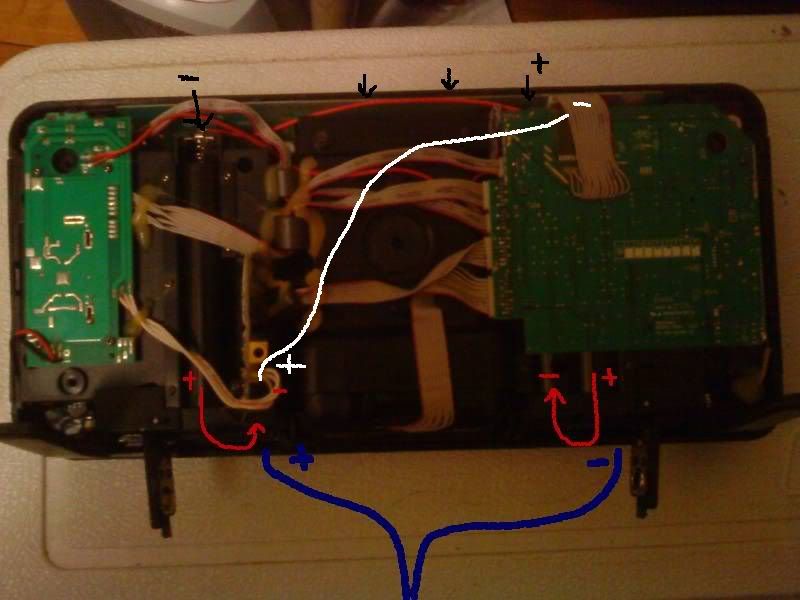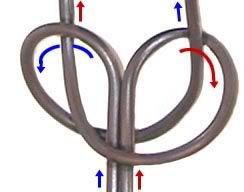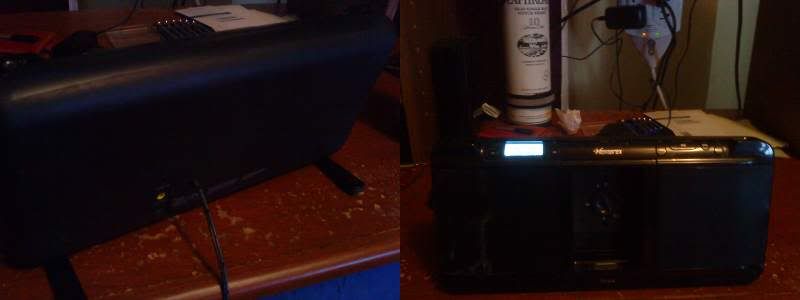The item in question is an obsolete, el cheapo Memorex iTrek, of which the manufacturer disavows all knowledge and no schematics are to be found. It operated one (1) time on battery power, after which the wall plug was the only option. Eventually, through a combination of flimsiness and careless treatment, the prong that jacks the power cord into the unit snapped off inside the device. I've never seen a jack-prong quite like this one: about 2mm diameter, mostly hollow, and about as sturdy as aluminum foil. The iTrek got shoved in its case and stuffed in the closet for a year and a half.
Last week, I was in project mode and dug it out. Step one, I stared at the thing until I found screw holes, and unscrewed until I was 78% sure I had them all. I then took my largest flathead screwdriver and started prying the two halves of the plastic casing apart, all the way around the edges. When prying open small electronics for which you have no guide or schematics, it's best to assume you will break it at this step. Miraculously, I did not (well, not badly).
Don't mind the arrows and squiggly lines for now, but laid open, it looked something like this:
 Sorry for the crappy phone pics.
Sorry for the crappy phone pics.The circuit board with the power jack stands upright toward the left, with the jack itself between the white line's positive end and the red arrow's negative. I removed the board's securing screw and unseated it (without breaking any wire connections) to get a better look. The best solution for most devices, even laptops, is to find the jack's solder marks on the bottom of the circuit board, figure out which is negative and which positive, and solder the respective wire ends from your power cord directly on top. I don't have a solder gun, nor a budget for power tools, presently, so I needed another option.
I got a half-assed idea about using the contacts on the doors to the battery compartment, which led me to what I should have done first: mapping the power circuit. The white line in the above photo is traced over the black wire which connects the right-hand battery compartment to the positive end of the power jack. What you can't really see, jutting off the other side, is a trapezoid of thin, bent metal, split into two tines at the end: the contact where power feeds from the left-hand battery compartment to the negative end of the DC jack.
Armed with this information, the solution became obvious:

Now, this is a power cord; it's going to get tugged on at some point, and a solderless splice would pull apart pretty quickly under pressure. Fortunately, my eighth grade shop teacher bestowed upon me knowledge of the underwriter's knot, which acts as a shock-absorber to prevent power cords pulling loose from their contacts.

credit unavailable, c/o Google images
So, once I had a gameplan, my steps were:
1. drill a new hole for the cord in back casing
2. with a utility knife, cut the remains of the jack-in off the cord
3. split apart the cord for a length of 3" to 5" and strip the insulation from the last 1"
4. thread the cord through the new hole in the back casing
5. tie the underwriter's knot inside the casing
6. cut the wire I traced in white, strip the end, and splice with the negative power wire*
7. with needle-nose pliers, straighten out the metal contact and pull apart the tines, careful not to pull it off the circuit board
8. coil the positive wire around one tine, then cross the two tines over each other and twist them together**
9. insulate both splices with decent electrical tape or heat-shrink tubing
10. reseat the circuit board, repositioning wires as needed, and so:

*I used a Western Union Splice:

credit unavailable, c/o Google images
**I held the end near the circuit board steady with my needle-nose and twisted with regular pliers
So that was my extremely half-assed methodology. Maybe it will be of some use planning your own half-assery, though I wouldn't recommend it.

3 comments:
Thank you mate for the great information abou this dock. Mine is working fine but in future emergency will see this by help of this post.
WIRING DIAGRAM
Here is the wiring schema for the Memorex iTrek, iPod docking station.
The set of three WHITE wires, located to the left of the internal power connector & stereo jacks, are the power leads for the docking station. Their designations are as follows:
White with dashed RED line - HOT
White with RED lettering - GROUND
White with RED Xs - the switch b/w external power and internal battery power.
The factory barrel connector is of inferior quality and breaks easily. What I found best as a solution to this is to cut the power leads from the female (internal)power connector and solder on a larger, more sturdy barrel connector directly to the appropriate White wires, not to the circuit board.
This will require you to replace both the female (in the docking station) and male (on the power wall wart) barrel connectors.
The device is polarity sensitive so you must have the HOT connected to the center pin and the GROUND connected to the outer jacket.
Connect (Solder) the new female barrel connector to the Hot (WHITE/RED dashed wire) and the Ground (WHITE/RED lettering wire). Remember the center pin is HOT.
Connect (Solder) the new male barrel connector to the Power Supply (Wall Wart).
Again, remember the center is HOT.
A side note: Portable, butane soldering irons and the few supplies (solder, butane, flux, solder wick) you need to solder are inexpensive, last a long time, and are relatively easy to use once you remember not to set them down on anything combustible.
Wow, just seeing the above comment from some time ago: hilarious that you were hacking away at the identical piece of cheap crap, though you seem to be better informed than I was (or am). The iTrek is still my bathroom radio, with a line out for my tablet. Coincidentally, I ordered my first soldering iron (cheap electric) from Amazon today to repair a laptop power jack.
Post a Comment